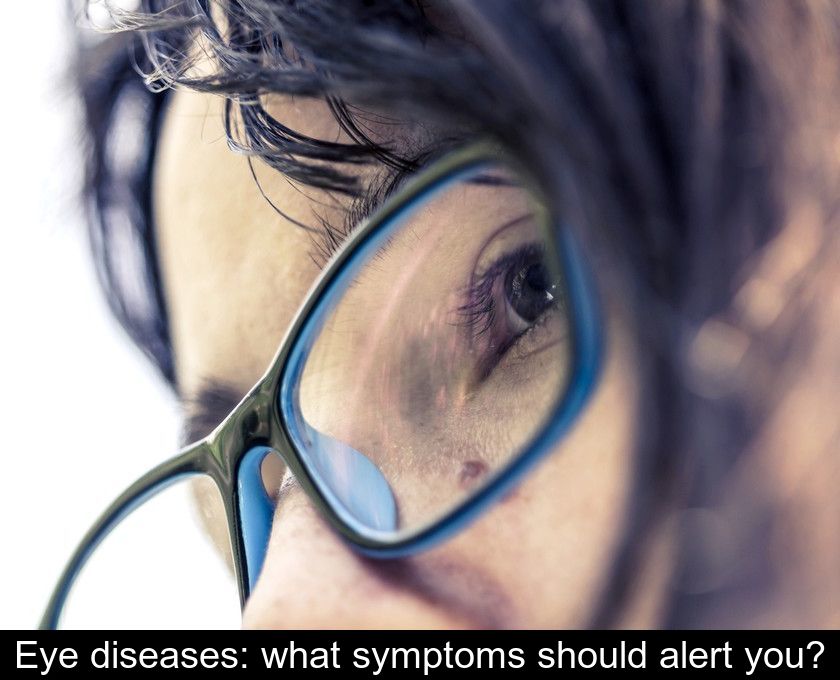Eye Diseases: What Symptoms Should Alert You?
Various pathologies can affect the eyes. If some eye diseases are benign, others require an emergency consultation with an ophthalmologist. Here is a small summary of the symptoms that should alert you.
A black veil with light points or a fixed flash
These various signs are the symptoms of retinal detachment. Among the most serious eye diseases, retinal detachment affects only one eye.
This problem manifests itself as a black haze on the sides that progresses toward the center of the field of vision and is accompanied by bright spots or the presence of a fixed flash that continues to be seen even with the eyes closed.
The black veil, fixed flash and bright spots are symptoms that should alert you because retinal detachment is a serious problem that particularly affects certain patients:
- people who are very nearsighted
- people with diabetes or high blood pressure
- people who have suffered an eye injury
- people who have had cataract surgery
To be noted: these symptoms should not be confused with isolated 'flies' that fly in front of the eyes and are the result of a much more commonplace problem, vitreous detachment (the viscous fluid inside the eyeball).
While the flying flies will go away spontaneously, the bright spots, fixed flash and black haze should prompt you to consult an ophthalmologist within a day.
When this problem is diagnosed early enough, retinal detachment can be treated with laser. After that, actual surgery is needed to repair the retina. Even worse, when the detachment is total, it results in permanent vision loss.
Pain in one eye
Pain that occurs in only one eye is another symptom that should alert you because it can be a sign of several eye diseases: acute glaucoma, ophthalmic herpes or ophthalmic shingles.
As a rule, it is not worrisome to have eye pain if both eyes are affected. It can be an allergy, dry eyes or an easily treated viral infection.
On the other hand, there are three cases in which only one eye is affected and urgent consultation is needed :
- acute glaucoma manifests as very severe pain, sometimes accompanied by nausea, as the pressure increases in the eyeball. In this case, you should of course consult without delay so that your sight is not damaged.
- Ophthalmic herpes and shingles are infections that cause redness and pain in an eye and can spread to the cornea at the risk of destroying it.
In cases of herpes or shingles, the pain increases and the vision decreases. It is located at the back of the eye and seems to spread deep into the skull. It also tends to wake up at night or become stronger when you get up.
These are all signs that tell you that this is not just ordinary conjunctivitis and that you should seek emergency consultation, within hours of the onset of the pain.
A sudden drop in vision in one eye
If you notice that your vision has suddenly decreased on one side, you should get an appointment with your eye doctor immediately or go to the hospital eye emergency room. This sudden drop in vision in only one eye may be a sign of Horton's disease.
Among the most serious eye diseases, this inflammation of the temporal artery also manifests as a flare-up of fever, headache, or pain in the forehead or temple.
In this case, too, it is important to react quickly because the reduced blood flow to the eye can lead to partial or total loss of sight, which is then irreversible. Don't wait to consult a doctor, as the rapid administration of cortisone can save your second eye.
A red eye in a contact lens wearer
Most of the time, having red eyes is not a cause for concern: it's a sign of an allergy or simple eye irritation. But, in people who wear contact lenses, a red eye is a symptom that should alert.
It can indeed be an infection with potentially serious complications, such as an abscess destroying the cornea.
If you wear contact lenses and notice that one of your eyes has reddened, you should immediately remove them and request an appointment with your ophthalmologist within half a day or go to the emergency room and bring the lens in its case with you.
To be noted: this worrisome symptom should not be confused with a painless hemorrhage in the white of the eye. There is no need for an emergency consultation when small vessels burst on the surface. Simply report this problem to your general practitioner at your next medical visit so that he or she can take your blood pressure.










